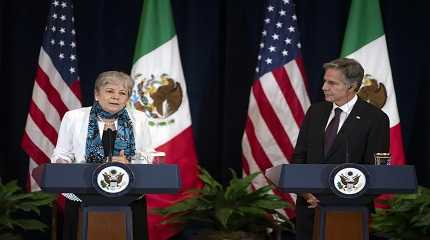
MEXICO CITY (AP) — U.S. Secretary of State Antony Blinken and other top American officials are visiting Mexico on Wednesday to discuss shared security issues, foremost among them trafficking of the synthetic opioid fentanyl, but also arms trafficking and increasing migration.
The latest round of the High-Level Security Dialogue brings Blinken, U.S. Attorney General Merrick Garland and Homeland Security Secretary Alejandro Mayorkas, among others, together with their Mexican counterparts for two days of talks.
Heightened migration is expected to be discussed as President Joe Biden’s administration comes under increasing pressure from Republicans and mayors from the president’s own party to do more to slow migrant arrivals.
Blinken was scheduled to discuss migration Wednesday with Mexico’s Foreign Affairs Secretary Alicia Bárcena, as well as the foreign ministers of Colombia and Panama.
New York City Mayor Eric Adams took a separate trip through Latin America aimed at learning more about asylum seekers’ paths to the U.S.
In a press conference Wednesday night in Mexico City, Adams said he hoped to “manage expectations” of migrants setting out on their journeys, and to inform migrants that his city was “at capacity” after receiving around 120,000 migrants over the past year.
He echoed a rising number of voices in calling for a larger global response to the increasing number of migrants to the U.S.
“It’s not sustainable,” Adams said at the base of a basilica where people often pray before setting out on their journeys. “The message of this not being sustainable cannot stay within the boundaries of New York City. … There is a global migration and it must have an international response.”
In August, the U.S. Border Patrol made 181,509 arrests at the Mexican border, up 37% from July but little changed from August 2022 and well below the more than 220,000 in December, according to figures released in September.
On Tuesday night, hundreds of migrants arrived in the northern Mexican border city of Ciudad Juarez across the border from El Paso, Texas aboard a freight train. They clambered off the train and immediately made their way to the border where they stopped at coils of barbed wire.
Elizabeth Romero, 32, left Venezuela three months earlier with her husband and 6-year-old son. She was three weeks pregnant then and spent her first trimester hiking through the jungle-clad border of Colombia and Panama, and most recently spent three days aboard the freight train that brought her to the U.S.-Mexico border.
She and her son, who celebrated his 6th birthday atop a freight car this week, have suffered bouts of fever. They left Venezuela because they couldn’t make ends meet financially. Her family remains there.
“We hope that the United States receives us and gives us the support that we need,” Romero said. They planned to turn themselves into U.S. authorities at the border because they had already waited three months without receiving an appointment to request asylum through CBP One, a mobile app.
The U.S. has tried to get Mexico and countries farther south to do more. In April, the U.S., Panama and Colombia announced a campaign to slow migration through the treacherous Darien Gap dividing Colombia and Panama. But migration through the jungle has only accelerated and is expected to approach some 500,000 people this year.




